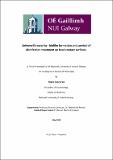Salmonella enterica - biofilm formation and survival of disinfection treatment on food contact surfaces.
| dc.contributor.advisor | Cormican, Martin | |
| dc.contributor.advisor | Morris, Dearbhaile | |
| dc.contributor.author | Corcoran, Mary | |
| dc.date.accessioned | 2013-07-15T15:56:16Z | |
| dc.date.available | 2013-07-15T15:56:16Z | |
| dc.date.issued | 2013-05-31 | |
| dc.identifier.uri | http://hdl.handle.net/10379/3515 | |
| dc.description.abstract | A recent report indicated that Salmonella was the most frequently identified agent in food-borne outbreaks in Europe. Salmonella can survive on surfaces and act as a source of cross-contamination. Biofilm formation may allow Salmonella enterica survival on surfaces and persistence in food processing environments for extensive periods of time. In 2008 there was a large food-borne outbreak of Salmonella Agona linked to a food processing facility. Prior to this outbreak, S. Agona was less frequently implicated in food-borne infections. The S. Agona strain SAGOXB.0066 and a variant strain remained in the environment for an extensive period of time. This lead to the hypothesis that the S. Agona strain may have a high propensity to form a biofilm and withstand disinfection treatment. The objectives of this research were to investigate if S. Agona SAGOXB.0066 may form a more dense biofilm than other S. enterica strains. Secondly, to investigate if S. enterica biofilm density increased over an extended period of time. Thirdly, to examine if S. enterica biofilm results in enhanced bacterial survival post disinfection treatment. The results indicate there was no evidence to suggest that S. Agona SAGOXB.0066 or the variant strain formed a more dense biofilm than other S. Agona strains after 48-hours. However there is some limited evidence to suggest that the serovar S. Agona may from more dense biofilm than other serovars. The results also indicate that S. enterica strains were able to withstand disinfectant treatment after biofilm formation. A number of S. enterica biofilm studies have tended to examine a limited number of strains or a single biofilm substratum. This research enhances the understanding of the S. enterica biofilm formation through the use of multiple strains. Moreover, the results illustrate the extent to which variation in repeated measurements on the same strain or the impact of different biofilm development models may contribute to apparent difference between strains examined. | en_US |
| dc.rights | Attribution-NonCommercial-NoDerivs 3.0 Ireland | |
| dc.rights.uri | https://creativecommons.org/licenses/by-nc-nd/3.0/ie/ | |
| dc.subject | Salmonella | en_US |
| dc.subject | Salmonella enterica | en_US |
| dc.subject | S. Agona | en_US |
| dc.subject | S. Typhimurium | en_US |
| dc.subject | S. Enteritidis | en_US |
| dc.subject | Biofilm formation | en_US |
| dc.subject | Food contact surfaces | en_US |
| dc.subject | Glass | en_US |
| dc.subject | Steel | en_US |
| dc.subject | Polycarbonate | en_US |
| dc.subject | Glazed tile | en_US |
| dc.subject | Concrete | en_US |
| dc.subject | CDC Biofilm Reactor | en_US |
| dc.subject | 48 hour biofilm | en_US |
| dc.subject | 168 hour biofilm | en_US |
| dc.subject | Salmonella biofilm tolerance to disinfectants | en_US |
| dc.title | Salmonella enterica - biofilm formation and survival of disinfection treatment on food contact surfaces. | en_US |
| dc.type | Thesis | en_US |
| dc.local.final | Yes | en_US |
| nui.item.downloads | 5227 |


